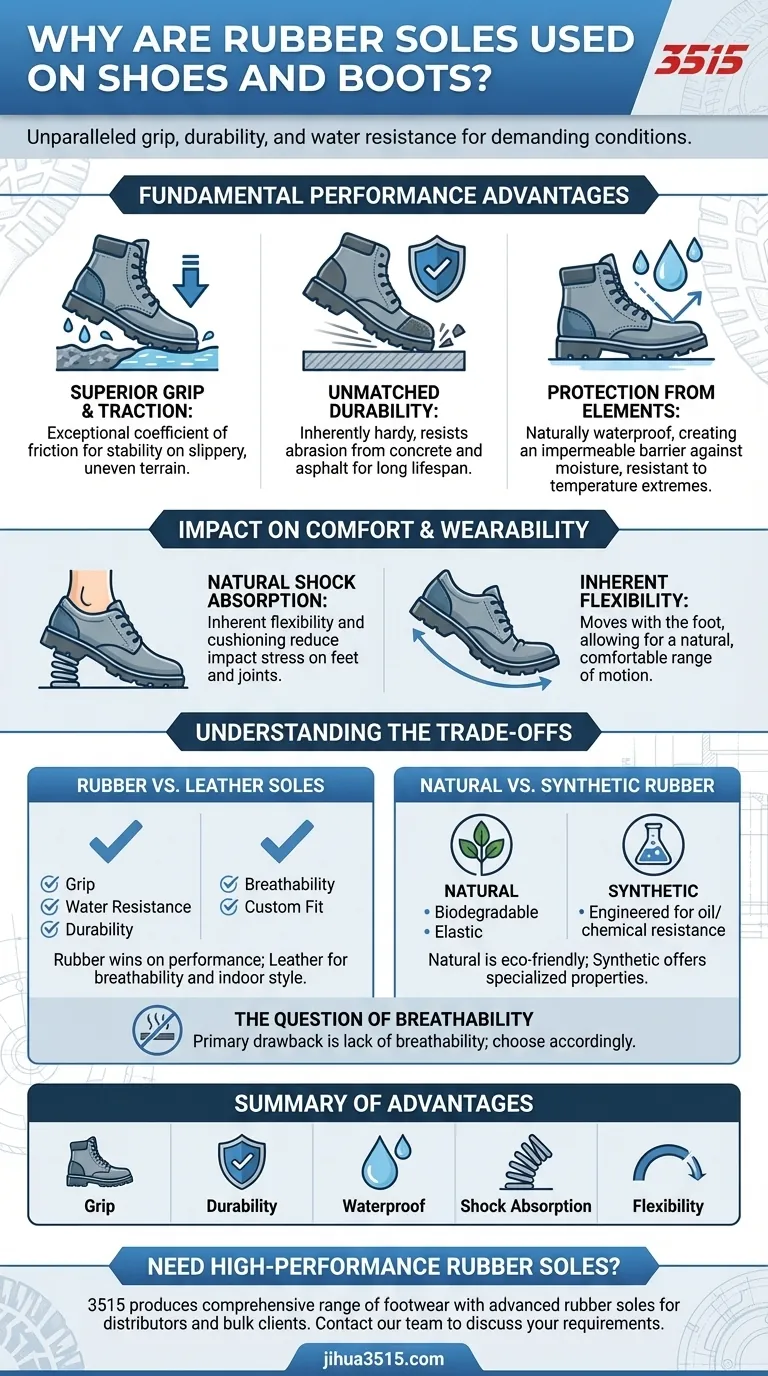At its core, rubber is used for shoe soles because of its unparalleled combination of grip, durability, and water resistance. This versatile material provides a protective and reliable foundation between your foot and the ground, excelling in conditions where other materials like leather would falter.
The choice of a sole material is a foundational engineering decision that dictates a shoe's performance, comfort, and lifespan. Rubber is selected when the primary needs are exceptional traction, resilience against wear, and protection from the elements.

The Fundamental Performance Advantages of Rubber
The physical properties of rubber make it uniquely suited for the demanding job of a shoe sole. It addresses three critical areas of performance: grip, durability, and environmental protection.
Superior Grip and Traction
Rubber exhibits a high coefficient of friction, which gives it an exceptional ability to grip surfaces. This quality is crucial for stability and safety.
This is especially true on wet, slippery, or uneven terrain, where rubber's ability to conform to micro-imperfections in the ground provides reliable traction.
Unmatched Durability and Abrasion Resistance
Footwear soles are subjected to constant friction and impact. Rubber is inherently hardy and resists being worn down by abrasive surfaces like concrete and asphalt.
This means a rubber sole will typically last much longer than a softer material like leather, making it a practical and economical choice for everyday wear.
Protection From the Elements
Rubber is naturally waterproof. A solid rubber sole creates an impermeable barrier that prevents water from seeping into the shoe from below.
It also offers excellent resistance to a wide range of temperatures, providing a consistent level of performance in both hot and cold conditions.
Beyond Performance: The Impact on Comfort and Wearability
While performance is key, a sole must also be comfortable. Rubber's natural elasticity contributes significantly to the overall feel and wearability of a shoe.
Natural Shock Absorption
The inherent flexibility and cushioning properties of rubber help to absorb the impact of each step. This reduces the stress transferred to your feet, ankles, and knees.
This quality is especially important in sneakers and work boots, where you spend prolonged periods on your feet.
Inherent Flexibility
A good shoe should move with your foot, not against it. Rubber can be formulated to offer excellent flexibility, allowing for a more natural and comfortable range of motion.
Quiet and Low Maintenance
As a practical benefit, rubber soles are significantly quieter to walk in than hard leather soles. They also require very little maintenance to keep them performing well.
Understanding the Trade-offs: Rubber vs. Other Materials
No single material is perfect for every application. Understanding where rubber stands in relation to other common materials is key to making an informed choice.
Rubber vs. Leather Soles
This is the most common comparison. Rubber wins on grip, water resistance, and durability. Leather is prized for its high breathability and its ability to conform precisely to the shape of your foot over time, offering a custom fit.
For a formal dress shoe used primarily indoors, leather is often preferred for its classic profile. For any shoe intended for outdoor or variable conditions, rubber is the superior technical choice.
Natural vs. Synthetic Rubber
Natural rubber, sourced from rubber trees, is biodegradable, highly elastic, and eco-friendly.
Synthetic rubbers are petroleum-based polymers. They can be engineered to have specific properties, such as extreme resistance to oil or chemicals, that may be required for specialized work boots.
The Question of Breathability
The primary drawback of rubber is its lack of breathability. Because it is waterproof, it does not allow moisture vapor (sweat) to escape through the sole, a benefit offered by materials like leather.
Making the Right Choice for Your Needs
Ultimately, the ideal sole depends entirely on the shoe's intended purpose.
- If your primary focus is all-weather performance and safety: A rubber sole is non-negotiable for its superior grip and waterproofing.
- If your primary focus is longevity and low maintenance: A durable rubber sole will outlast most alternatives and require minimal care.
- If your primary focus is formal style and breathability: A traditional leather sole may be more appropriate, accepting the trade-offs in grip and weather resistance.
- If your primary focus is environmental impact: Seek out footwear made specifically with natural, sustainably sourced rubber.
Understanding the properties of a sole empowers you to choose footwear that performs exactly as you need it to.
Summary Table:
| Advantage | Key Benefit |
|---|---|
| Superior Grip | Excellent traction on wet or uneven surfaces |
| Unmatched Durability | Resists abrasion from concrete and asphalt |
| Waterproof Protection | Creates a barrier against moisture |
| Shock Absorption | Reduces impact on feet, ankles, and knees |
| Flexibility | Allows for natural and comfortable movement |
Need high-performance rubber soles for your footwear line?
As a large-scale manufacturer, 3515 produces a comprehensive range of footwear with advanced rubber soles for distributors, brand owners, and bulk clients. Our production capabilities encompass all types of shoes and boots, ensuring the perfect balance of grip, durability, and comfort your customers demand.
Contact our team today to discuss your sole requirements and get a quote!
Visual Guide

Related Products
- Factory-Direct Wholesale Canvas Boots with High-Traction Rubber Soles
- Safety Footwear Wholesale Manufacturer for Custom OEM/ODM Production
- Factory Direct Wholesale Rain Boots Durable Waterproof & Fully Customizable
- Wholesale Waterproof Tactical Boots Custom Suede & High-Traction Soles
- Wholesale Leather Ankle Boots with Lug Soles for Custom Brand Manufacturing
People Also Ask
- Why is rubber a popular material for shoe soles? Unbeatable Grip, Durability & Value
- What factors determine the slip resistance of rubber-soled shoes? Tread, Compound & Design Explained
- What role do slip-resistant rubber materials play in safety shoes? Ensuring Grip and Stability in Hazardous Workplaces
- What types of rubber are typically employed in non-slip footwear soles? Your Guide to Maximum Grip and Safety
- Why is rubber commonly used for non-slip soles? The Science of Superior Grip



















